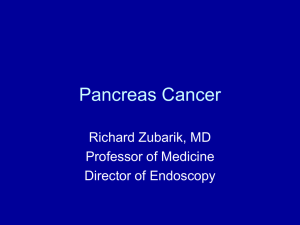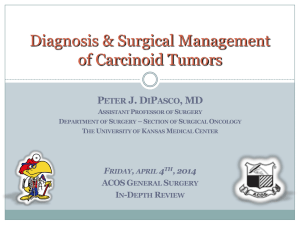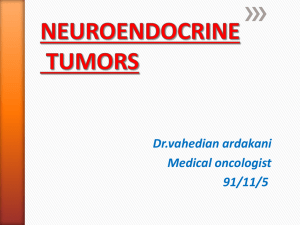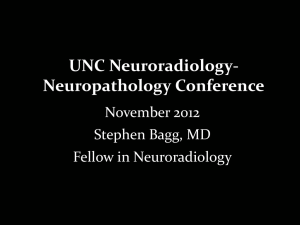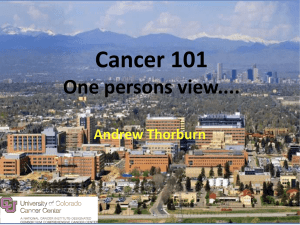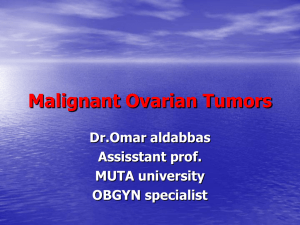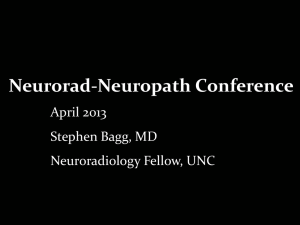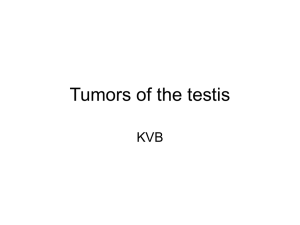Endocrine Tumors of GIT
advertisement
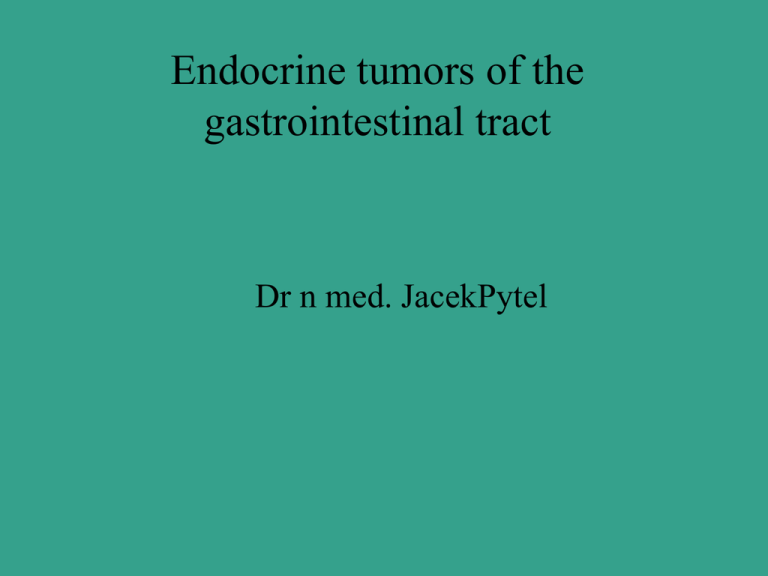
Endocrine tumors of the gastrointestinal tract Dr n med. JacekPytel Endocrine tumors of the gastrointestinal tract • In 1902 secretin was discovered by Bayliss and Starling • Among the cells covering the gastrointestinal tract are single cells with characteristic typical endocrine cells They create a kind of "diffuse"endocrine organ scattered intraepithelial endocrine glands Endocrine tumors of the gastrointestinal tract • Thanks to cytochemicalimunohistochemistry- and fluorescent reactions presence of these glands in the epithelium were found in gastrointestinal tract and in the islands of Langerhans of pancreas, adrenal medulla, bronchial epithelium, fallopian tubes, vagina and uterus Endocrine tumors of the gastrointestinal tract • These cells are characterized by the ability to capture and metabolize biogenic amines and their precursors, and synthesizing small molecule and peptide hormone secretion Endocrine tumors of the gastrointestinal tract • Properties: Amine precursor uptake and decarboxylation APUD Endocrine tumors of the gastrointestinal tract • APUD system cells origin from neuroectoderm and migrate to the mucosa of primitive gut and the buds of future organ in embryonic development Endocrine tumors of the gastrointestinal tract • This same origin as the cells of the nervous system, chemoreceptors cells, adrenal medulla cells Endocrine tumors of the gastrointestinal tract • Digestive tract there are a lot of active peptides gastrin, secretin, cholecystokininpancreozymin (CCK-PZ) - classified as hormones - regulate physiological functions of the gastrointestinal tract Endocrine tumors of the gastrointestinal tract • The epithelial cells of gastrointestinal tract and pancreatic endocrine function displaying can develop cancer of a APUDoma They can be „silent” or produce characteristic symptoms of hormone secretion Endocrine tumors of the gastrointestinal tract • The incidence 5-20 cases per million population per year • In about 70% of patients have the syndrome of multiple endocrine tumors type I (Multiple Endocrine Neoplasia - MEN) • Hormonally inactive tumors - significantly more Endocrine tumors of the gastrointestinal tract • 3% of pancreatic cancers - neuroendocrine tumors (ca. 76% - hormonally inactive) • Resective in approximately 76% (pancreatic cancer 19%) • 30-50% located outside the pancreas • About 50% - malignant Endocrine tumors of the gastrointestinal tract • Treatment aimed at inhibiting grow tumor and reduce the excessive production of hormones • Somatostatin analogs effectively control the secretion of hormones • The therapeutic target for tumor treatment Endocrine tumors of the gastrointestinal tract • 80-90% of neuroendocrine tumors has somatostatin receptor Somatostatin analogues (octreotide, lanreotide, RC-160)-for treatment, Diagnostics - marked octreotide - to scyntygraphy Endocrine tumors of the gastrointestinal tract • Endocrine tumors serotonin capture (precursor 5-hydroxytryptophan) PET (positron emission tomography - PET) for locating small changes undetectable by scyntygraphy use octreotide Endocrine tumors of the gastrointestinal tract Diagnostics • Angiography of the celiac trunk • USG • Computed tomography CT • MRI Magnetic resonance tomography • Scyntygraphy (isotope indium-labeled octreotide (In111) • Endoscopic Ultrasonography - EUS Endocrine tumors of the gastrointestinal tract Diagnostics: - Arterial stimulation venossus sampling ASVS - Transhepatic portal venosus sampling THPVS - Intraoperative usltrasonography - Intraoperative hormone measure Endocrine tumors of the gastrointestinal tract • 20-60% insulinomas fails to specify the position before the operation 10-20% intraoperatively (experienced surgeon - 90% of the palpable sense) Endocrine tumors of the gastrointestinal tract • Treatment: chemotherapy: streptozotocin and 5 fluorouracil, doxorubicin, cispaltyna (partial remission for about two years 40-60%) Interferon alpha - 50% biochemical response, tumor reduction 20% Somatostatin analogues (octreotide), symptomatic and biochemical response 3575% Endocrine tumors of the gastrointestinal tract • Treatment: There is no uniform pattern of diagnostic and therapeutic - Removal of the tumor or tumors - Liver metastases - arterial embolization, liver transplant! Endocrine tumors of the gastrointestinal tract • treatment: - Radiation therapy - tumors generally resistant to radiotherapy - Isotope-labeled somatostatin analogue itrium (Y90) Insulinoma • 1869-Langerhans - described the pancreatic insulas Insulinoma • 1902 - Nicholls described a pancreatic endocrine tumor cells • The incidence of approx. 0.5-5 / 1 million persons / year • The most common tumor causing hypoglycemia • Other tumors - beyond the pancreas insulin-secreting growth factors (IGFinsulin-like growth factors) Insulinoma • 60% of all pancreatic insulomas Tumor diameter 5-60 mm aprx. 20 mm 90% of cases does not exceed 20 mm 10% of multiple endocrine syndrome (MEN 1) 10-15% of malignant Insulinoma Clinical symptoms: Whipple’ triad - occurrence of spontaneous hypoglycemia - low blood glucose levels below 50 mg% - regression of hypoglycemia after oral or intravenous administration of glucose Insulinoma • Treatment of choice - surgery Insulinoma • Approximately 70% of patients after surgery recover • Perioperative mortality rate is 10% • In the case of malignant changes in the average survival time is about 2 years Insulinoma Ultrasonografia przedoperacyjna Insulinoma Ultrasonografia przedoperacyjna Tomografia komputerowa Insulinoma Tomografia komputerowa – guz w głowie trzustki Insulinoma Ultrasonografia śródoperacyjna Guz o średnicy 13 mm na pograniczu głowy i trzonu trzustki Insulinoma Ultrasonografia śródoperacyjna Dobrze odgraniczony guz o średnicy 10 mm w okolicy wyrostka haczykowatego Insulinoma Złośliwy guz naciekający śledzionę, liczne przerzuty w wątrobie Insulinoma Mały guz ostro odgraniczony od miąższu trzustki Insulinoma Mały guz trzustki – 21 mm Insulinoma Ultrasonografia endoskopowa Insulinoma Ultrasonografia endoskopowa Insulinoma Laparoskopia Gastrinoma • Gastrinoma - a tumor, which causes gastrin releasing hypergastrinaemia and increased gastric acid secretion Tumors: ovarian cancer, bronchial carcinoid may secrete gastrin, but in such quantity that do not cause hypergastrinaemia Gastrinoma • In1955 Zollinger and Ellison described a syndrome: • - Persistent, recurrent ulcers stomach or duodenum, even after partial gastric resection and vagotomy • - Excessive basal secretion of gastric acid • - The presence of pancreatic cancer island cells derived from D Gastrinoma • Frequency of gastrinoma 0.5-10 / 1mln/per year • About 0.1% of patients with peptic ulcer disease Gastrinoma • Excessive production of gastrin by tumors derived from not beta-cell (G cells) pancreatic islet • 70% malignat tumors • In 20% of single tumor • Often develop slowly and multifocuses • Metastasis in to lymph nodes and liver but rarely to the lung. • In about 20% occur in MEN I syndrome Gastrinoma Zolliner Ellison Syndrom: -The presence of multiple peptic ulcers in the esophagus, stomach or duodenum -Hipersecretion gastrc acid -The presence of pancreatic tumor secreting gastrin Gastrinoma Symptoms: - Abdominal pain associated with active peptic ulceration or perforation in the course of morbus ulcerosus - Diarrhea caused by excessive production of gastric juice - Tarry stools due to bleeding from the upper gastrointestinal tract Gastrinoma The symptoms and laboratory results gives rise to a suspicion of ZES: -Recurrent peptic ulcer disease resistant to treatment -Basal secretion of gastric juice above 15 mmol HCl /h -Ratio of primary to a maximum of gastric acid secretion (BAO: MAO) does not exceed 0.6 -Gastrin concentration in serum above 500 pg / ml (normal up to 200 pg / ml) - In tests with intravenous administration calcium, glucagon, or secretin in patients with ZES showed an increase in gastrin Gastrinoma Treatment The basic goal Inhibition of gastric acid secretion with high acidity by surgery Tumor resection Not always possible Ectopic placement metastases Total gastric resection Multifocus changes Gastrinoma Prognosis In the case of ZES good provided hypersecretion and eradicate gastric hyperacidity Malignant neoplasms in many cases - may grow slowly Survival can be long Gastrinoma Vipoma Vernera-Morrisona Syndrom (1958), WDHA – watery diarrhea hypokalemia achlorhydria Tumor derived from pancreatic islet beta produced vasoactive intestinal hormon, often malignant, usually single, 80% of pancreatic APUDoma Clinical symptoms •persistent watery diarrhea (more than 3l / d) •symptoms of hypokalaemia •asthenie achlorhydria •Tetany (as a result of hypomagnesaemia) WDHA syndrom diagnosed very rare o Pure prognosis Vipoma Liczne przerzuty w wątrobie Vipoma Tomografia komputerowa Glukagonoma The tumors derived from pancreatic islet alpha cells secrete glucagon, about 70% is malignant, approximately 100 cases yet documented in the world Clinical symptoms •hiperglikemia •skin lesion - erythema migrans with necrosis places •stomatitis •hemolytic anemia •elevated glucagon levels above 500 pg / ml diagnosis - Clinical signs + pancreatic tumor Glukagonoma Glukagonoma Somatostatinoma The tumors associated with tumor cell proliferation delta pancreatic islet •are extremely rare •large virulence •previously documented in the world only a few dozen cases Diagnosis and treatment is the same as in other pancreatic tumors derived from the APUD system cells Somatostatinoma Carcinoid • WHO classification term - carcinoid replaced - neuroendocrine tumors Carcinoid • 0,5-2,1 / 100 000 persons per year - on alimentary tract • 0.3 / 100 000 persons per year - bronchus Carcinoid Carcinoid 85% alimentary tract - appendix 44% - rectum 15% - ileum 11% 10% lungs 30% non malignat tumors Carcinoid The incidence of -appendix - rectum, ileum tumor below in diameter 1 cm 2 cm metastase 2% 80 % Slow growth - 5-year survival in more than 70% of operated patients Carcinoid • Carcinoid - of I part of the primitive gut (respiratory system, thymus, stomach, duodenum) - Usually secrete corticotropin-CRH, ACTH, somatolibertin (growth-releasing hormone-GH-RH), serotonin, gastrin, glucagon Carcinoid • Carcinoid tumors of the second part primary gut (ileum, colon ascendens) usually secrete serotonin, tachykinins, bradykinin, chromogranin A The final part of the primary gut (colon, rectum) are often hormonal inactive, can produce chromogranin A, human chorionic gonadotropin Carcinoid Clinical symptoms Carcinoid syndrome is caused by the action of vasoactive substances - serotonin •flush •diarrhoea •bronchospasmus - rare •damage to the right side of the heart valves Carcinoid • Carcinoid crisis) in patients with metastatses, usually to the liver. Usually after induction (biopsy, surgery) - a significant drop in pressure, feeling beat and palpitations, massive watery diarrhea, shortness of breath, abdominal cramps, asthma attacks, flushing of the face, neck, upper part, hyperthermia Carcinoid • Carcinoid crisis- a life-threatening condition. Requires intensive treatment. - Octreotide 100 micro grams - Histamine receptor blockers Carcinoid • Cardiac symptoms (carcinoid heart disease) - subendocardial deposition of collagen – thickening, distortion and narrowing of the tricuspid valve and pulmonary trunk Carcinoid Treatment Extensive excision of the primary tumor and regional lymph nodes In the case of liver metastases hepatic artery embolization Adjuvant treatment - cytostatics Symptomatic treatment - serotonin inhibitors (cyproheptydyna), somatostatin analogues Rakowiaki Klinika Chirurgii Endokrynologicznej i Ogólnej UM w Łodzi 1974 - 2005 Apendektomie 3371 zagięcie śledzionowe okrężnicy 1 guz śr. 120 mm Hemikolektomie 512 jelito cienkie 1 guz śr. 30 mm wyrostek robaczkowy 4 guzy o śr. od 5 do 15 mm krezka jelita cienkiego 1 guz śr. 35 mm był przyczyną martwicy jelita cienkiego Rakowiak jelita cienkiego Rakowiak oskrzela Rakowiak oskrzela – obraz endoskopowy Rakowiak wyrostka robaczkowego Rakowiak jelita Rakowiak jelita Przerzuty do węzłów chłonnych

